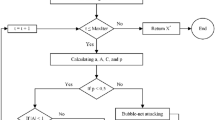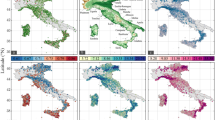Abstract
Reservoir operation rules are intended to help an operator so that water releases and storage capacities are in the best interests of the system objectives. In multi-reservoir systems, a large number of feasible operation policies may exist. System engineering and optimization techniques can assist in identifying the most desirable of those feasible operation policies. This paper presents and tests a set of operation rules for a multi-reservoir system, employing a multi-swarm version of particle swarm optimization (MSPSO) in connection with the well-known HEC-ResPRM simulation model in a parameterization–simulation–optimization (parameterization SO) approach. To improve the performance of the standard particle swarm optimization algorithm, this paper incorporates a new strategic mechanism called multi-swarm into the algorithm. Parameters of the rule are estimated by employing a parameterization–simulation–optimization approach, in which a full-scale simulation model evaluates the objective function value for each trial set of parameter values proposed with an efficient version of the particle swarm optimization algorithm. The usefulness of the MSPSO in developing reservoir operation policies is examined by using the existing three-reservoir system of Mica, Libby, and Grand Coulee as part of the Columbia River Basin development. Results of the rule-based reservoir operation are compared with those of HEC-ResPRM. It is shown that the real-time operation of the three reservoir system with the proposed approach may significantly outperform the common implicit stochastic optimization approach.









Similar content being viewed by others
References
Afshar A, Shafii M, Bozorg Haddad O (2011) Optimizing multi-reservoir operation rules: an improved HBMO approach. J Hydroinformatics 13(1):121–139
Bozorg Haddad O, Afshar A, Mariño MA (2006) Honey-bees mating optimization (HBMO) algorithm: a new heuristic approach for water resources optimization. Water Resour Manag 20(5):661–680
Celeste AB, Billib M (2009) Evaluation of stochastic reservoir operation optimization models. Adv Water Resour 32(9):1429–1443
Chandramouli V, Deka P (2005) Neural network based decision support model for optimal reservoir operation. Water Resour Manag 19(4):447–64
Chandramouli V, Raman H (2001) Multireservoir modeling with dynamic programming and neural networks. J Water Resour Plan Manag 127(2):89–98
Chang FJ, Chen L, Chang LC (2005) Optimizing the reservoir operating rule curves by genetic algorithms. Hydrol Process 19(11):2277–89
Chen L (2003) Real coded genetic algorithm optimization of long term reservoir operation. J Am Water Resour Assoc 39(5):1157–1165
Chuanwen J, Bompard E (2005) A self-adaptive chaotic particle swarm algorithm for short term hydroelectric system scheduling in deregulated environment. Energy Conversat Manag 46(17):2689–2696
Columbia River System Analysis Model-Phase I (1991).US Army Corps of Engineers, Hydrologic Engineering Center, PR-16.
Davis L (1991) Handbook of genetic algorithms, Van Nostrand Reinhold.
Eberhart RC and Kennedy J (1995) A new optimizer using particle swarm theory. Proceedings of the Sixth International Symposium on Micro machine and Human Science, 39–43, IEEE service Center, Piscataway, NJ.
Eberhart RC and Shi Y (1998). Comparison between genetic algorithms and particle swarm optimization. Proc., 7th Annual Conf. on Evolutionary Programming: VII, Springer, New York, 611–616.
Evers GI, and Ghalia BM (2009) Regrouping particle swarm optimization: A new global optimization algorithm with improved performance consistency across benchmarks. Proceedings of IEEE International Conference on Systems, Man and Cybernetics, 3901–3908.
Fallah-Mehdipour E, Bozorg Haddad O, Mariño MA (2011) MOPSO algorithm and its application in multipurpose multireservoir operation. Journal of Hydroinformatics, Online
Ginn TR, Houck MH (1989) Calibration of an Objective Function for Optimization of Real-Time Reservoir Operations. Water Resour Res 25:591–604
Hydrologic Engineering Center (1990) HEC-PRM Supplemental programs. HEC, Davis, CA.
Izquierdo J, Montalvo I, Pérez R, Fuertes VS (2008) Design optimization of wastewater collection networks by PSO. Comput Math Appl 56(3):777–784
Jalali MR, Afshar A, Mariño MA (2007) Multi-colony ant algorithm for continuous multi-reservoir operation optimization problem. Water Resour Manag 21(9):1429–1447
Johnson SA, Stedinger JR, Staschus K (1991) Heuristic operating policies for reservoir system simulation. Water Resour Res 27(5):673–685
Karamouz M, Houck MH (1982) Annual and monthly reservoir operating rules generated by deterministic optimization. Water Resour Res 18(5):1337–1344
Kennedy J, and Eberhart RC (1995) Particle swarm optimization. Proceedings of IEEE International Conference on Neural Networks, IV: pp.1942-1948. IEEE Service Center, Piscataway, NJ.
Klipsch J (2002) HEC-RESSIM: Capabilities and plans. Second Federal Interagency Modeling Conf, Las Vegas
Koutsoyiannis D, Economou A (2003) Evaluation of the parameterization– simulation–optimization approach for the control of reservoir systems. Water Resour Res 39(6):1170
Kumar D, Reddy J (2007) Multiple reservoir operation using particle swarm optimization. J Water Resour Planning Manag 133(3):192–202
Labadie JW (2004) Optimal operation of multireservoir systems: State-of-the-art review. J Water Resour Plan Manage 130(2):93–111
Liu H, Abraham A (2001) Fuzzy adaptive turbulent particle swarm optimization. Proceedings of IEEE International Conference on Evolutionary Computation, IEEE 101–106.
Liu H, Abraham A, Zhang W (2007) Fuzzy Adaptive Turbulent Particle Swarm Optimization. Int J Innov Comput Appl 1(1):39–47
Matott LS, Rabideau AJ, Craig JR (2006) Pump-and treat optimization using analytic element method flow models. Adv Water Resour 29(5):760–775
Mehta R, Jain SK (2009) Optimal operation of a multi-purpose reservoir using neurofuzzy technique. Water Resour Manage 23(3):509–29
Moeini R, Afshar A, Afshar MH (2010) Fuzzy rule-based model for hydropower reservoirs operation. Int J Electr Power Energy Syst 33(2):171–178
Mousavi S, Ponnambalam K, Karray F (2007) Inferring operating rules for reservoir operations using fuzzy regression and ANFIS. Fuzzy Set Syst 158(10):1064–82
Pardalos PM, Resende MGC (eds) (2002) Handbook of Applied Optimization. Oxford University Press, New York
Salman A, Ahmad I, Al-Madani S (2002) Particle swarm optimization for task assignment problem. Microproc and Microsyst 26(8):363–371
Shourian M, Mousavi SJ, Tahershamsi A (2008) Basin-wide Water Resources Planning by Integrating PSO Algorithm and MODSIM. Water Resour Manag 22:1347–1366
Suribabu CR, Neelakantan TR (2006) Design of water distribution networks using particle swarm optimization. Urban Water J 3(2):111–120
Tejada-Guibert JA, Johnson SA, Stedinger JR (1993) Comparison of two approaches for implementing multireservoir operating policies derived using stochastic dynamic programming. Water Resour Res 29(12):3969–3980
Wang Yi-min, Chang Jian-xia, Huang Q (2010) Simulation with RBF Neural Network Model for Reservoir Operation Rules. Water Resour Manag 24:2597–2610
Yeh WWG (1985) Reservoir management and operations models: A State-of-the-Art Review. Water Resour Res 21(12):1797–1818
Young GK Jr (1967) Finding reservoir operating rules. J of the Hydraul Div ASCE 93(HY6):297–321
Acknowledgements
Special thanks to Hydrologic Engineering Center, Davis, CA for their great help and support specifically in giving authors the permission to use data and HEC Res-PRM as part of this research. This is an academic research and any outputs will have no relevance or application to the operation of the Columbia River system.
Author information
Authors and Affiliations
Corresponding author
Rights and permissions
About this article
Cite this article
Ostadrahimi, L., Mariño, M.A. & Afshar, A. Multi-reservoir Operation Rules: Multi-swarm PSO-based Optimization Approach. Water Resour Manage 26, 407–427 (2012). https://doi.org/10.1007/s11269-011-9924-9
Received:
Accepted:
Published:
Issue Date:
DOI: https://doi.org/10.1007/s11269-011-9924-9




